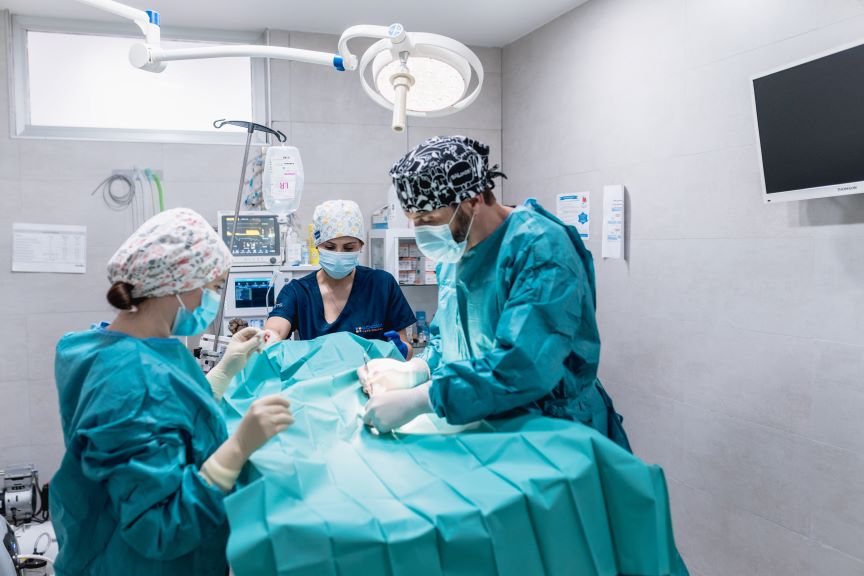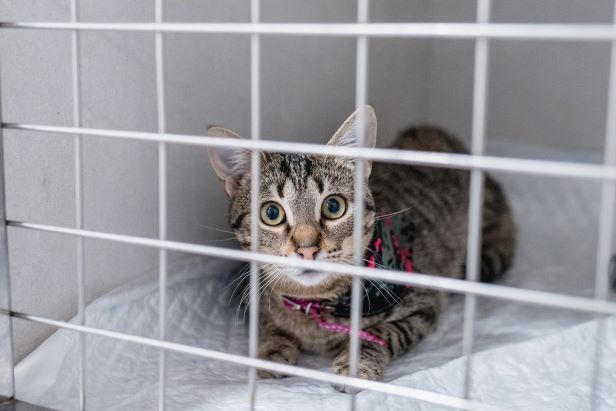Our oncologists at Especies Veterinarios care for pets with cancer from the diagnosis to the treatment, or during the terminal period for your pet. Our main objective is to provide the best quality of life for animals suffering from cancer, achieve remission or cure from the disease, minimize the side effects of therapy and offer palliative treatment and end-of-life care.
The most common tumors treated are:
- Lymphoma.
- Leukemia.
- Mast cell tumors.
- Feline fibrosarcoma.
- Osteosarcoma.
- Soft tissue sarcoma.
- Tumors of the mammary gland.

Surgery Considerations
Whenever cancer surgery is being considered, you should discuss the costs and benefits with one of our veterinarians at our hospital in Valencia.
Possible Benefits
- Complete cure and a disease-free life
- Reduced pain
- Improved quality of life
- Prolonged life
Possible Costs
- Potential complications of surgery, including infections, bleeding, recurrence of the cancer, and undesirable changes in appearance
- Short- or long-term pain and discomfort
- Loss of normal function in affected limbs or organs
Surgery overview
Surgery is considered the cornerstone for treating most cancer and tumours in animals. It is one of the oldest forms of treatment and considered the most effective one. Currently, surgery may be combined with radiation therapy and/or chemotherapy, depending on the characteristics of the case.
When surgery is performed, the main goal is usually to remove all the cancerous cells in the animal’s body. Sometimes, if the cancer is detected early (before it grows too large or spreads to other parts of the body), surgery can completely cure your pet. Other goals of surgery can include removing an unsightly tumour to improve the animal’s appearance or comfort or removal of a tumour that is interfering with your pet’s normal body functions. These goals can improve the quality of life of your pet.
Surgery is most successful when the cancerous tumour has not spread beyond its original location. However, unfortunately some tumours cannot be surgically removed. Some are in inaccessible sites. And, there are times when the costs to the animal might outweigh the benefits. For example, removing a large tumour might require removing a vital organ or may cause a pet to lose a vital body function. If the cancer has spread to more than one location (metastasized), then surgery alone is less likely to be an effective treatment.
A biopsy is a surgical procedure in which a piece of tumour is removed for study and analysis by a pathologist. The pathologist’s report will provide important information such as the type of cancer and its characteristics. Combined with information about the size and location of the cancer, your veterinarian can develop the best treatment program for your pet.
Chemotherapy
Certain drugs (chemicals) destroy cancer cells. This type of treatment is called chemotherapy. Chemotherapy can be used to manage and treat several types of cancer. When it is used, the most common treatment goal is to shrink, stop the growth of, or destroy the cancer without longterm negative effects on the quality of life of the animal. Your veterinarian will prescribe chemotherapy based on the type of cancer needed to be treated, the stage of the cancer, the overall condition of the animal, and any financial constraints that may be present.
In an ideal situation, a chemotherapy drug would kill cancer cells in an animal’s body without harming normal healthy cells. Few such drugs have been found. Today, the drugs selected for chemotherapy have been designed to be more damaging to cancer cells than to normal cells. They specifically target cells that divide and grow rapidly. Normal cells will be affected to some extent by chemotherapy drugs, and sometimes the drugs can have adverse effects.
Chemotherapy drugs are administered either by mouth or by injection. If injection is used, it can be into a vein (intravenous), muscle (intramuscular), or under the skin (subcutaneous). The delivery method will be selected with the comfort and quality of life of the pet in mind balanced against the goal of effective delivery of the drugs.
Chemotherapy alone usually cannot cure cancer in pets. It is used most often to control cancer and its spread. Thus, chemotherapy is often used to treat cancers that affect the whole body, such as cancer of the lymphatic system (lymphoma). In other cases, chemotherapy is used to fight the remaining cancer cells when a tumor cannot be completely removed with surgery. Chemotherapy is also used to fight types of cancer that spread around the body early in their development.
In all cases, your veterinarian must weigh the expected benefits of the drugs with possible adverse effects to select the most appropriate treatment for your pet. The veterinarian will carefully monitor your pet’s physical and behavioural response to the treatment and adjust the dosage to maximize the effect on the cancer while reducing the side effects.
Animals generally appear able to tolerate chemotherapy better than people, but treatment with some chemotherapy drugs may lead to vomiting or a lack of interest in food. This side effect can be treated with anti-nausea medicine. Intravenous fluids can be used to control such side effects as vomiting, diarrhea, and dehydration.
Dogs and cats receiving chemotherapy usually have good to excellent quality of life throughout the treatment program. Side effects, if any, are usually mild. The risk of life-threatening adverse effects is estimated at less than 5% for most types of chemotherapy. If your pet will be undergoing chemotherapy, you should discuss the treatment program with your veterinarian in advance. You need to come to a mutual understanding about what you can expect for your pet and the level of risk you are willing to accept.
Combination Therapy
The term combination therapy refers to the use of 2 or more treatment options in the fight against cancer. Today, combination therapy is the most frequently used approach to treat cancer in pets. It offers the best opportunity to cure the cancer while maintaining the best possible quality of life for the animal.
Combination chemotherapy offers many advantages over single drug treatment programs. For example, when multiple chemotherapy drugs are used, and each one uses a different mechanism to kill cancer cells, it is less likely that the cancer will become drug resistant. This improves the chances that the treatment will be successful.
There is no single best treatment for all cancers. For some cancers, the best approach is one that combines surgery, radiation therapy, and chemotherapy. Tumours and other cancers that are confined to a localized area are often best treated with surgery or radiation therapy. Chemotherapy has the advantage of treating cancer cells that have spread from their original location. In other cases, radiation or chemotherapy is used to shrink a tumour to a size that makes surgical removal possible or more likely to succeed. Radiation or chemotherapy may be used following surgery to kill any cancer cells that may remain.
The stage of cancer development is a factor in selecting the treatment, whether a single treatment mode or a combination of treatment methods. For animals with advanced cancers that cannot be treated with surgery or radiation therapy, combination chemotherapy can be used to reduce the signs of the disease and prolong life.

